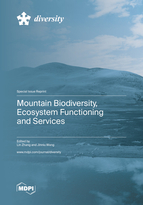Mountain Biodiversity, Ecosystem Functioning and Services
A special issue of Diversity (ISSN 1424-2818). This special issue belongs to the section "Biogeography and Macroecology".
Deadline for manuscript submissions: closed (31 January 2023) | Viewed by 34865
Special Issue Editors
Interests: alpine plant ecology and climate change; plant biogeography
Interests: treeline ecotone; plant functional trait; vegetation pattern; ecosystem services; mountain sustainable development
Special Issues, Collections and Topics in MDPI journals
Special Issue Information
Dear Colleagues,
Mountains encompass more than 30% of all land and 23% of the Earth’s forests with high levels of biodiversity and endemism, and support diverse habitats and refuges for approximately 85% of global amphibian, bird, and mammal species. More than 1/4 of the global human population inhabits mountain environments, many of whom are among the world’s poorest people. Local communities depend on the ecosystem services from mountainous regions to earn their living. However, the earth has experienced a significant transformation due to global change, i.e., agriculture and the exploitation of natural resources by human activities and extreme climate events. In particular, the consequences for the losses of biodiversity and ecosystem functioning are obvious in phenomenon but are largely unknown in mechanism across mountainous regions. Moreover, experiences and conclusions from studies in other regions are not applicable to predict the future scenarios of mountains with human activities, which may be mitigated or amplified by a rapidly changing environment with elevation. All these will seriously undermine ecosystem services and the livelihood and well-being of mountain communities and people. Hence, it is essential to figure out the underlying interaction and interplay of climate and anthropogenic factors modulating variation of biodiversity and ecosystem functions to reveal the consequences and challenges of global change for mountains. From the Hindu-Kush-Himalaya in Asia, the Alps, and the Central Mountain Range in Europe, to the Andes Mountains in South America, to the Rocky Mountains in North America, all these mountains have been exerting a tremendous impact on their biodiversity and ecosystem functioning from different levels and scales by climate change and human activities. If we shift focus to the Qinghai-Xizang Plateau, for its around 4000 m mean altitude above the sea level, “the roof of the world” is characterised by low temperature and short growing season but diverse ecosystems and multiple functions, with emerging special phenomena of “Colder soils in a warmer world”, “escalating woody-plants encroachment into grasslands”, and “the greening of alpine vegetation” which reduce biodiversity and alter ecosystem functions across alpine life zone in consequence. Biodiversity and nature’s benefits to people underpin almost every aspect of human development and are key to the success of the new Sustainable Development Goals (cited from IPBES). Under the background of the just-completed 2020 UN biodiversity Conference COP15 in Kunming, we must fulfill biodiversity conservation, construction of ecological civilization, and harmony between human and nature to build a shared future for all life on earth. This Special Issue, therefore, focuses on studies dealing with diverse organisms and multiple ecosystems across the mountains, and the response to climate change and human activities from valleys to remote alpine regions. We welcome multidisciplinary contributions dealing with the application of novel or multiscale methods and approaches in the context of biodiversity from the gene and individual, to ecosystems and landscapes, adaptations of organisms like plants, animals, micro-organisms, and spatio-temporal variation of vegetation patterns and land-use status, and possible driving factors mainly but not solely focusing on the functional adaptation of organisms to climate and anthropogenic changes from traits to communities and ecosystems as well as relevant ecosystem services. It is not just one mission but the vision to guarantee the harmonious development of human and nature guides our path toward a greener future, with growing resonance across the world. One indispensable component is to enable sustainable and resilient mountain development, which can enhance mountain people’s ability to adapt to climate, environmental, and socioeconomic change, and to enjoy the benefits and opportunities afforded by natural endowment.
Dr. Lin Zhang
Dr. Jinniu Wang
Guest Editors
Manuscript Submission Information
Manuscripts should be submitted online at www.mdpi.com by registering and logging in to this website. Once you are registered, click here to go to the submission form. Manuscripts can be submitted until the deadline. All submissions that pass pre-check are peer-reviewed. Accepted papers will be published continuously in the journal (as soon as accepted) and will be listed together on the special issue website. Research articles, review articles as well as short communications are invited. For planned papers, a title and short abstract (about 100 words) can be sent to the Editorial Office for announcement on this website.
Submitted manuscripts should not have been published previously, nor be under consideration for publication elsewhere (except conference proceedings papers). All manuscripts are thoroughly refereed through a single-blind peer-review process. A guide for authors and other relevant information for submission of manuscripts is available on the Instructions for Authors page. Diversity is an international peer-reviewed open access monthly journal published by MDPI.
Please visit the Instructions for Authors page before submitting a manuscript. The Article Processing Charge (APC) for publication in this open access journal is 2600 CHF (Swiss Francs). Submitted papers should be well formatted and use good English. Authors may use MDPI's English editing service prior to publication or during author revisions.
Keywords
- adaptation
- biogeography
- ecosystem functions
- functional traits
- genetic and species diversity
- global change
- landscape heterogeneity
- livelihood
- mountain environment
- sustainable development







